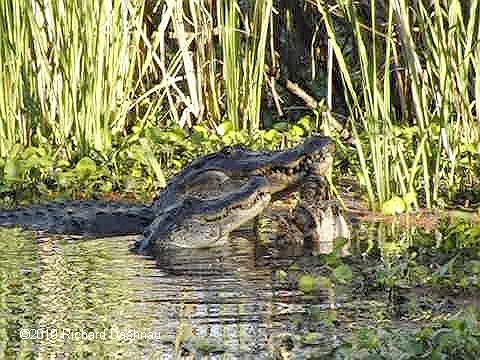 -
-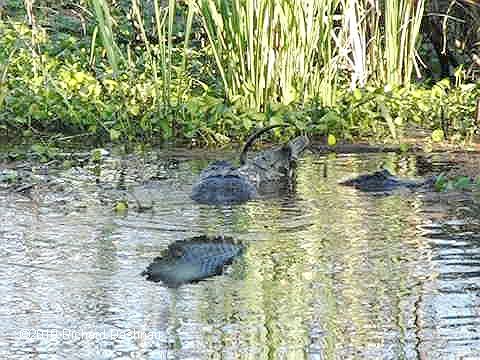
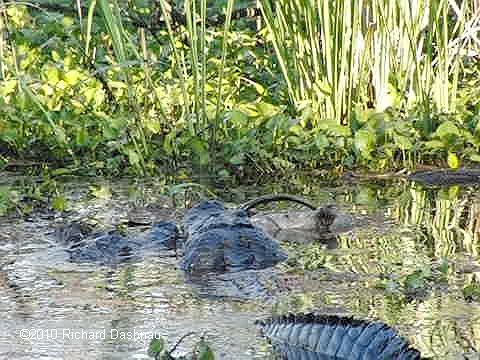 -
-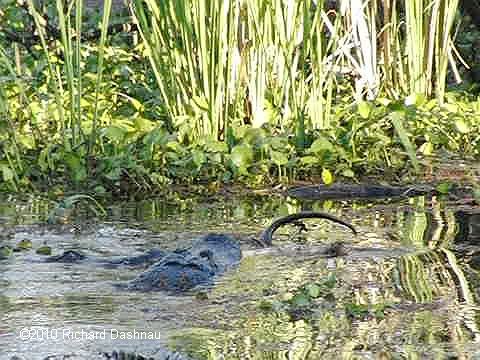 --
--
STOLEN MOUTHFUL THE BUCK STOPPED HERE TAKING AWAY THE FOOD 1 TAKING AWAY THE FOOD 2
Many
people have seen programs on television showing crocodiles
attacking large
animals like deer and cattle. While this is amazing, and
sometimes horrifying,
those
creatures are not alligators. Crocodiles' jaws are a bit
different than alligators' jaws, and are used differently.
Alligators favor prey
items that will fit inside their head.
That
is, if they can swallow it
whole, then they will normally attack it. Alligators sometimes
eat deer
in the park, but the larger ones were probably found
carcasses,
but small fawns might have been live captures. Alligators
have eaten large nutria (as I've shown on this website). But,
most of the time, they will
eat things like small fish,
frogs, and crayfish. Snakes and turtles are
also pursued, with alligators seeming to be especially
well-adapted for
eating turtles. A study done in Texas examined
the stomach contents
of about 50 alligators (which were unharmed). Research
showed that only
one of these alligators had eaten a bird (which couldn't be
identified,
it might have already been carrion when taken), and the rest had
stomach
full of small fish and shellfish. I've seen 11-foot
alligators going
after prey that was no larger
than their largest teeth (very small frogs
and fish).
 -
-
 -
- --
--
STOLEN
MOUTHFUL
THE
BUCK STOPPED
HERE
TAKING AWAY THE FOOD
1
TAKING AWAY THE FOOD
2
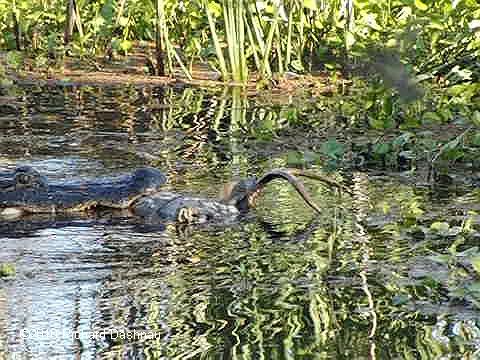
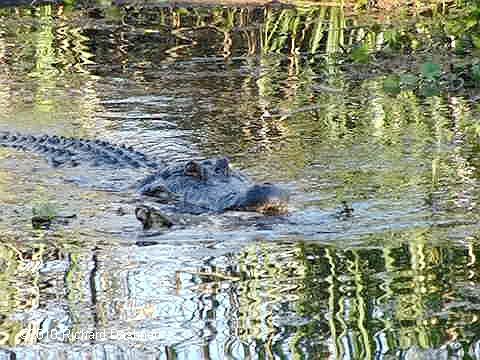 -
-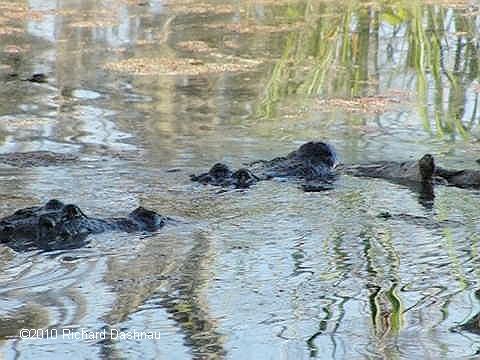 -
-
TAKING
AWAY THE FOOD 3
SWIMMING PAST THE BRIDGE
THE SMALLER DOESN'T GIVE UP
The
6' gator followed and continued trying to get pieces from carcass.
The
smaller alligator was quite persistant--even crawling on top of
the
larger
alligator to bite on the carcass. However,
through this entire
situation,
neither alligator exhibited any really aggressive behavior towards
the
other. In the pictures below, the smaller alligator demonstrates
how
poorly
the jaws work for
biting big chunks off of large prey--even with the
prey
held stationary.
-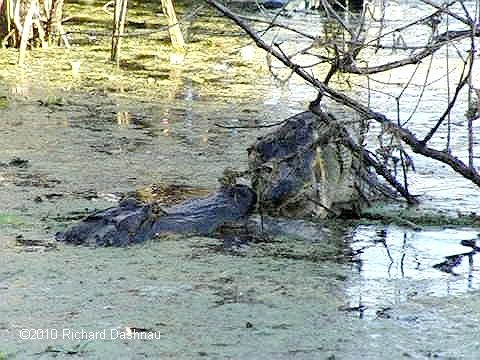 --
--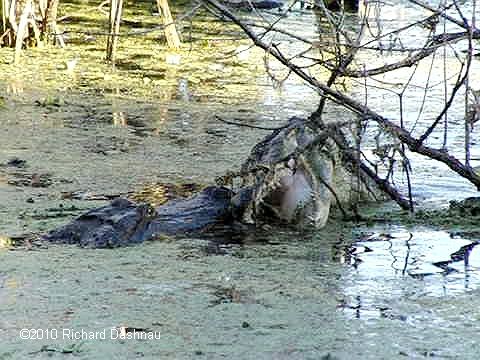 --
--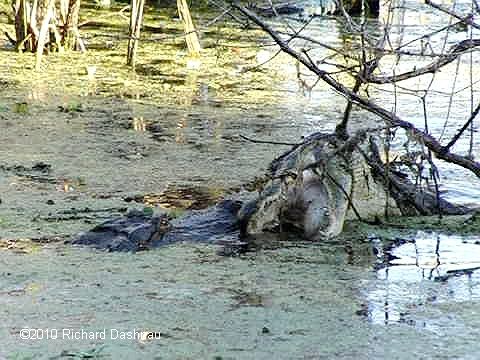
NOT EASY TO GRAB A MOUTHFUL 1
NOT EASY TO GRAB A MOUTHFUL
2
NOT EASY TO GRAB A MOUTHFUL 3
While
the large alligator was holding the carcass firmly in its jaws,
the
smaller
one could pull on it, and even roll to pull off pieces of flesh,
but
only
by gripping a small area. I don't care much
for the term "death roll".
In this case, the prey is already dead. This is a demonstration of
an
alligator's
habit of rolling when it encounters resistance while its jaws are
clamped
upon
something. In the second roll, one can see the exact moment there
is a sudden split when the carcass is overstressed by severe
twisting.
One can also note that only a small part of the
carcass is caught at
the
end of the alligator's jaws.
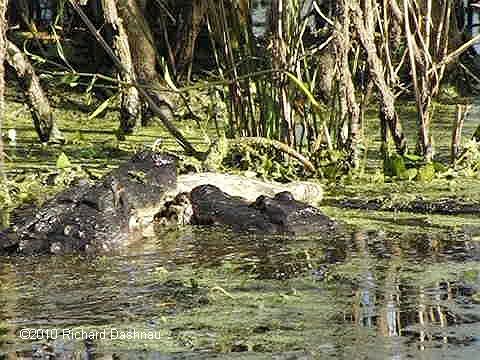 --
--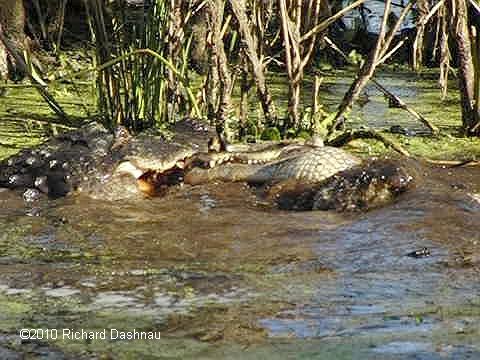 -
-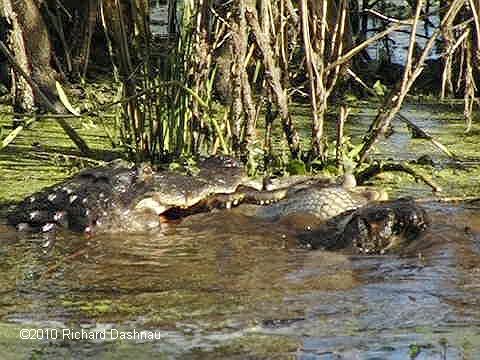 --
--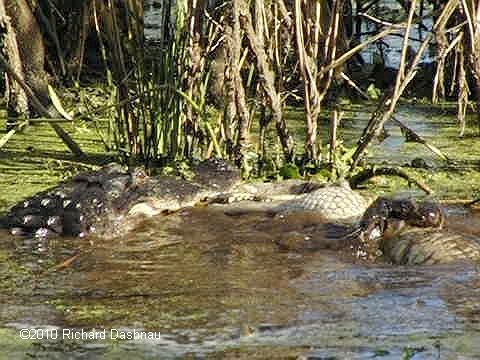 --
--
NOSE-TO-NOSE
FIRST
PREY-TEARING ROLL
1
FIRST PREY-TEARING ROLL
2
FIRST PREY-TEARING ROLL
3
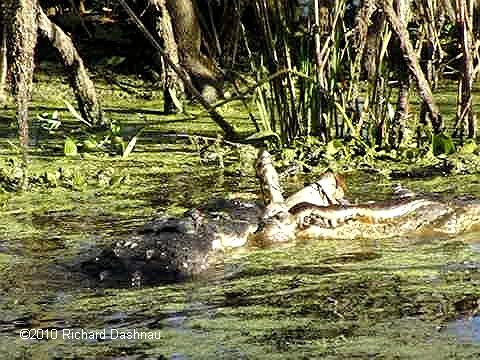
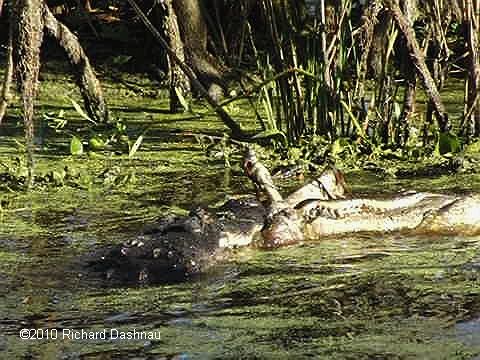 --
--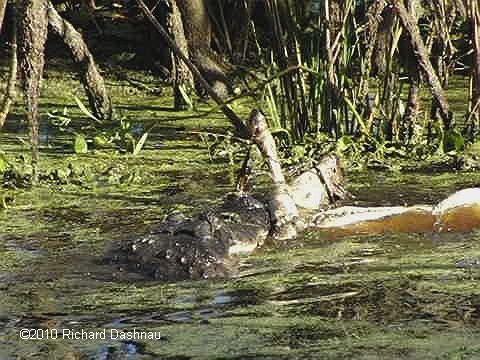 -
-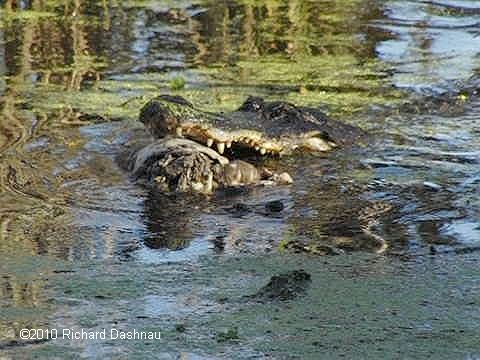
SECOND PREY-TEARING ROLL 1
SECOND
PREY-TEARING ROLL
2
SECOND PREY-TEARING ROLL
3
RE-SET THE CLAMP
1
--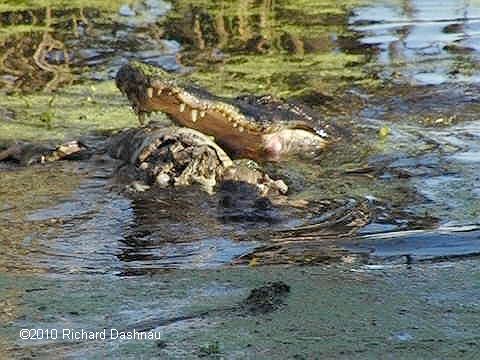 --
--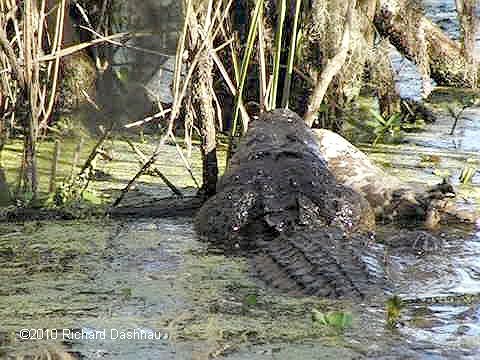
RE-SET THE CLAMP
2
THE HUGE JAW MUSCLES AT WORK
I
only
saw the large alligator try to spin the carcass only once--with
pretty
spectacular results. Since nothing was holding the carcass
fixed
for the larger alligator, everything moved along with
the alligator.
After
some time (at about 10:00am) the smaller alligator finally
pulled
off a leg. When this happened the large alligator finally became a
bit
agitated and tried to take the leg
back, but only for a few minutes.
The
smaller alligator swam off towards Elm Lake with the severed leg.
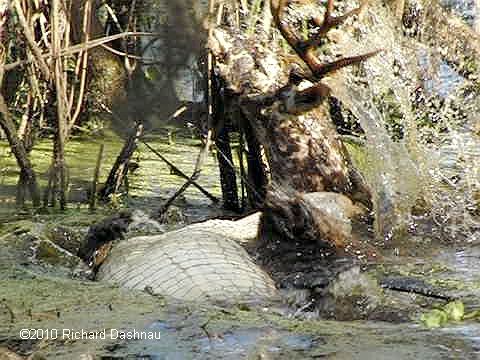 --
--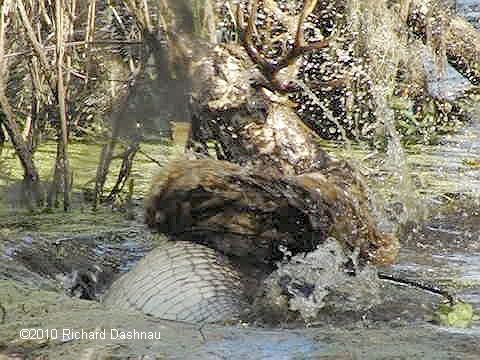 -
-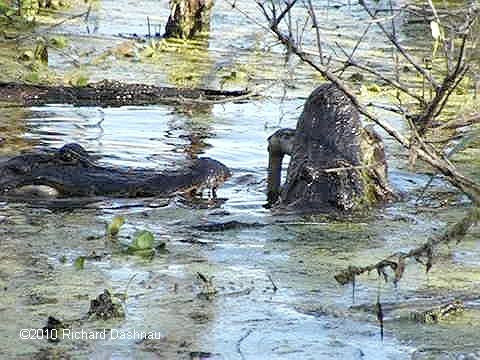 -
-
THE
BIG ALLIGATOR ROLLS!
1
THE BIG ALLIGATOR ROLLS!
2
THAT'S MY LEG, SHORTY!
The
large
alligator stayed with the carcass. It moved towards one of the
small
islands,
and seemed to rest, so I left to visit Elm Lake.
When
I came back about 30 minutes later, the large gator had cleared
logs
from
the area. It was pushing on one of the longer ones was I
watched.
Soon after, the smaller alligator returned
(about 11:15am). and went
right
for the larger alligator. Not only did it approach the larger
alligator,
but it approached quickly, and immediately went to the front of
the
larger
alligator's head.
It appeared to looking for the buck in the place
where
it had last found the carcass--in the larger alligator's
mouth. (So,
it appears that an alligator can accidently "food habituate" another
alligator.)
-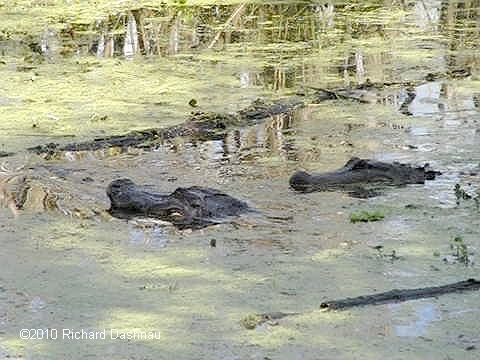 ------
------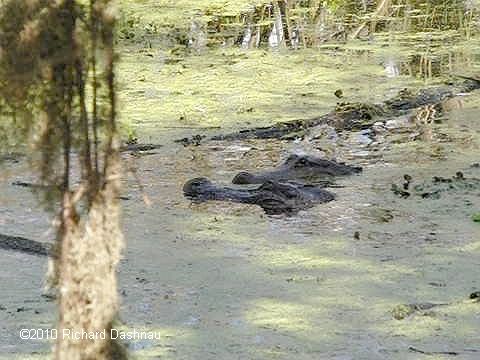
TIME TO STEAL ANOTHER BITE!
HEY...YOU
HAD A BUCK IN THERE A WHILE AGO
Since
the carcass wasn't there, the small alligator went looking for it.
This
caused the large alligator to become agitated, and it began trying
to
shove
and herd the smaller one away. At one
time, it even had the smaller
alligator's
head in its mouth, but it didn't clamp down on the smaller
alligator.
The
large alligator also did large gape signals, but with its head
mostly
submerged.
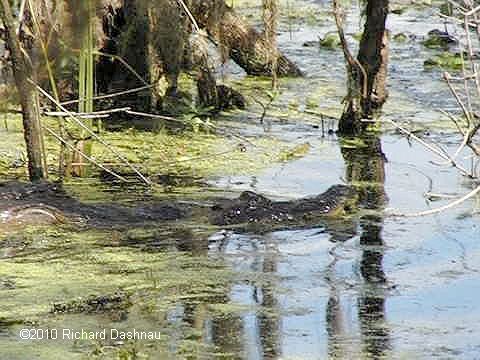 --
--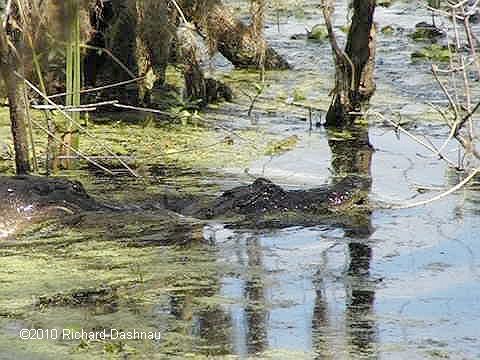 -
-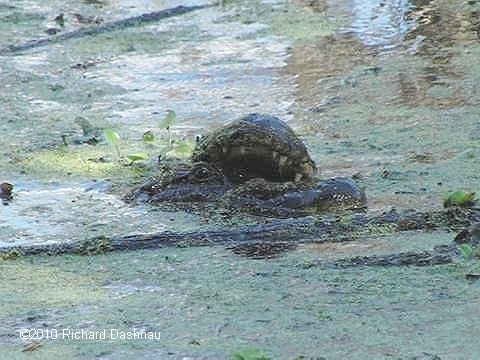 --
--
SLOWLY
CHASING THE SMALLER 1
SLOWLY
CHASING THE
SMALLER 1
BIG JAWS COVER SMALLER HEAD
1
-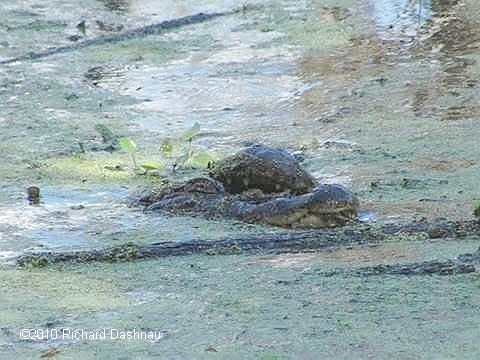 ------
------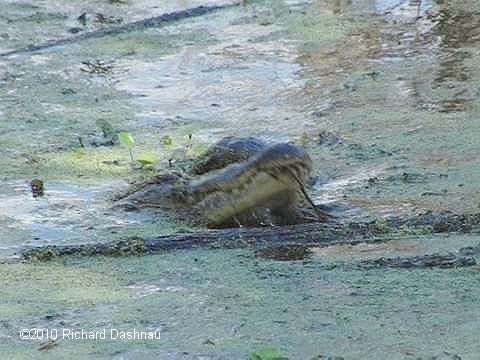
BIG
JAWS
COVER SMALLER HEAD 2
BIG JAWS COVER SMALLER
HEAD 3
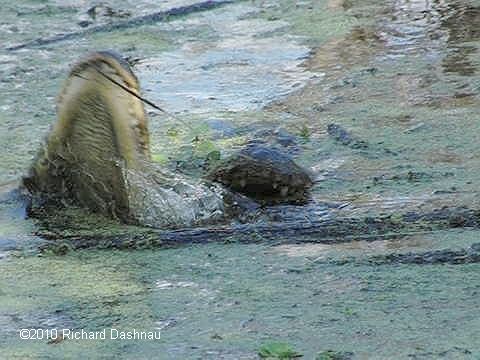 --
--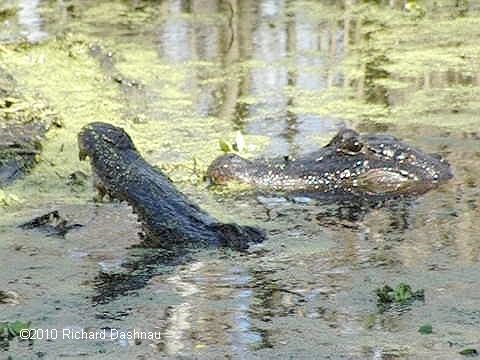 -
-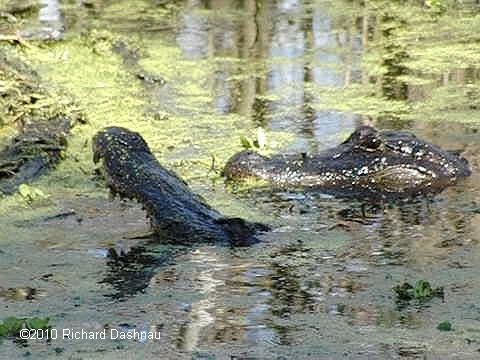 --
--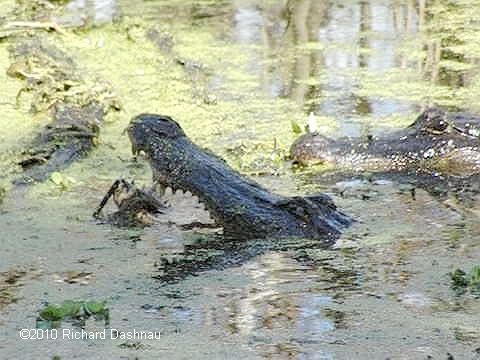 --
--
BIG
JAWS COVER SMALLER HEAD 4
UNDERWATER GAPE DISPLAY
1
UNDERWATER GAPE DISPLAY 2
UNDERWATER GAPE DISPLAY 3
The
smaller gator finally found the carcass, and swam towards Elm Lake
with
it; while somehow avoiding the notice of the large alligator.
I followed
the smaller alligator and the food, and when it got about 20 yards
away,
the large alligator started bellowing. It bellowed about 5 times,
and
then
stopped. It did not pursue the
smaller alligator. The smaller alligator
took its prize, and eventually pulled it past one of the islands
and
into
Pilant Lake and out of view. (about 12pm) Throughout those hours,
many
park
visitors came by, and I was able to talk with them through some of
this adventure and explain what was going on.
I am
still amazed by the tolerance of the larger alligator. While it is
true
that it did attempt to dissuade the smaller alligator; it didn't
try
very
hard; and was most passive about it. I did hear an
occasional hiss, but
at the distance I was watching, I couldn't tell which alligator
was
hissing.
This also was short, and not very loud. There was not a single
sudden
aggressive
movement
directed towards either alligator. There was lots of close
physical
contact, particularly around the snout and eyes; but the smaller
one
also
climbed across the back, head, and snout of the
larger one many
times.
The placing of the jaws around the head of the smaller one seemed
very
gentle--although the small one did snatch its head from out of
there
(BIG
JAWS 4 above
shows the head whipping out from under the top jaw). The
end
of the top jaw poking out of the water (which I assumed was
actually an
intimidation gape being done mostly under water) was
interesting, too.
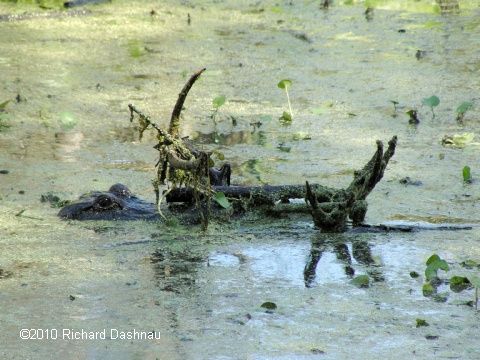 --
--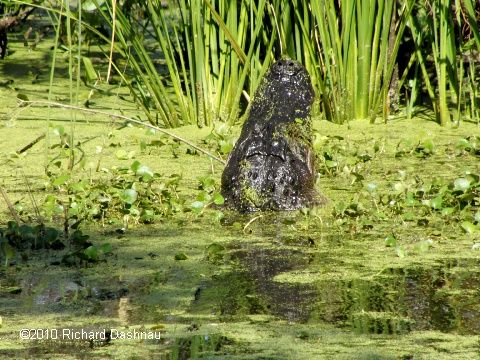 -----
-----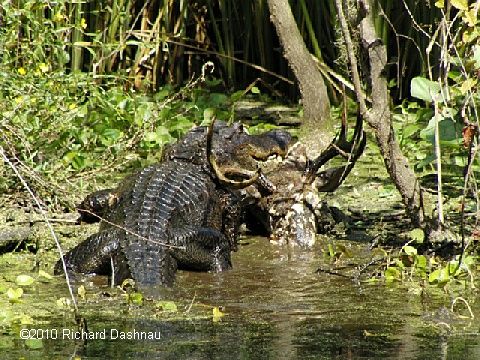 -
-
SMALLER
WITH STOLEN CARCASS
BELLOWING--FOR
LOST CARCASS?
SMALLER ONE WITH
THE STOLEN BUCK
I
was
able to catch different parts of this on video. I shot almost all
of it
at high speed because I expected to see some kind of aggressive
social
interaction and I wanted to slow it down. It
turned out that there was
hardly any aggression at all. I created a film using this
footage
and the few photos I shot. I sped up segments of the "slow motion"
video
to preserve the motion
paths, but to allow it to happen in a reasonable
time. Otherwise, everything else is as I filmed it. The edited
video is
about 12 minutes long, distilled from about 83 pieces of video
and
photos.
We don't see this kind of thing at Brazos Bend State Park very
often--
not with a deer, and not one this large. One of our visitors named
Sandy
shot photos of a deer being eaten
on the Pilant Slough side of the
Spillway
bridge in June of 2009. It does happen and sometimes we get to see
it.
It's usually unknown how an alligator would get a
deer in the first
place. In
this case, it seems likely that the deer was killed or
wounded
by a human hunter and the alligators just found it. Later, a large
alligator
was sunning itself on the trail just past the Spillway,
and because of
a couple features (one bad eye, possible scar under the good eye)
I
identified
it as the same large alligator. Comparison with my 6' walking
stick
showed
the alligator to
be about 8 feet long. The images on this
page are
from the edited video
clip
(160MB wmv).
03/09/2009--
I had the day off, and had visited the park again, hoping to find
an
Otter.
While I was walking the trail, I talked to some park visitors and
mentioned
that I had been
looking for an Otter. They got excited and told me that
they'd seen an alligator with a large furry carcass in its jaws.
The
alligator
was in 40 Acre Lake, and I was walking back from Elm
Lake on the
Spillway
Trail when I had this conversation. They's seen the
alligator
at
least an hour before I talked to them, and they thought that the
carcass
might be an Otter, but they
couldn't tell because the alligator was on
one of the islands. I quickly walked back to 40 Acre Lake to
try
to find the alligator, and identify its prey. I feel that this
information
could be
important for a few reasons.
First,
I have the opinion that although alligators are predators, and
often
eat
Nutria; Otters are also predators and are therefore smarter and
faster
than Nutria.
Predators have to stalk and chase their prey, and
therefore
require more effort to catch their prey. Herbivores don't have to
chase
their prey. Although both predators and herbivores also
can be hunted
by
other predators (and would have to have some means of escaping
from
them)
I believe that predators have more physical skill. I also feel
that
Otters
are smarter than
alligators, can swim at least as fast as they can, and
have more stamina than Alligators. So, I believe that alligators
rarely
catch Otters.
Second,
I believe that Otters are predators that share a niche with
Alligators
(they both exploit the same types of food). However, since they
are
warm-blooded,
they require much more
food than Alligators do. The park could not
support
a population of over 200 Otters, although that many alligators can
easily
live there. So, the number of Otters in the park must be
small,
and
it would be worthwhile to note the loss of an Otter.
Third,
I like Otters. I like Alligators, too, and
understand the need for
them both to share the environment. But, I was concerned that an
Otter
was lost, and would have been saddened by it.
Nutria
(Nutrias?) (Myocaster Coypus) are large rodents similar to
Muskrats and
Beavers. Unlike both of these though, the Nutria is a
non-indigenous
animal--an
"invasive species". I've
heard a few explanations of how they
got
here from South America. One is that they were brought here to
cultivate
for fur, and then they escaped (I heard a hurricane in Louisiana
blamed).
I've also heard that they were purposely introduced to some
waterways
to
help control invasive plant species (like water hyacinth); but
that the
Nutria starting eating everything. They are
displacing the
smaller,
native Muskrats, and are breeding more. Fortunately, here in the
South,
Alligators are here to help eat Nutria. I've got a short video
clip of
a Nutria swimming by on
my Otter page, here.
I finally
got to 40 Acre Lake, and there, right near the short footbridge,
was an
alligator with a furry carcass. This didn't surprise me, since
Alligators
are very possessive of their food, and
most of the other Alligators
were
out near the island. This Alligator had moved away from the
others.
When
I first approached, the Alligator slid off the bank and into the
water.
I had to wait,
without moving, about 15 feet away until the Alligator
decided
that I wouldn't be coming any closer (in fact, I'd retreated a few
steps
to indicate submission). The Alligator returned to the
bank,
and
came ashore. The front of the carcass was inside the jaws, and the
rest
of it was on the opposite side of the alligator. So, I couldn't
tell
what
the animal was, aside from the fact
that it had fur. It was still wet,
and I'm able to tell an Otter pelt from a Nutria's judging from
the
texture
of the fur.
In the
past, I'd been able to identify a mammal in an alligator's jaws by
shooting
bursts of photos of it while it chewed on a carcass. All I needed
was a
single shot that would show the
prey's face clearly enough so that the
huge incisors of a rodent would be visible (or not). My new camera
can
shoot a LOT of images in burst mode, but it can also shoot
high-speed
video.
I decided to go for the video.
I've
observed alligators trying to fragment prey before. Previous
examinations
of how this works can be seen on one of my pages here.
I hadn't
gotten ready to film the alligator before he did two prey-whipping
movements,
and then he was done. I probably couldn't have asked for a better
video.
The
images below are all frame grabs from one of two video clips I
shot.
I have
not shown parts of the latter part of the first clip as photos
here.
Predators
feed by eating other animals. In almost every case, the capture
and
subsequent
handling and processing
of the prey is...not without violence, or
implied
violence. Images showing this process can upset some people.
Sorry, but
that's what happens when predators eat. Something has died,
and then it
has to be eaten. I was able to capture the moments when an
alligator is
successful in tearing prey by pulling against what seems to
be--air.
The
series of images below show the the mechanics of what I've called
a
"prey
whip". Clicking the images will show them in their original size
(320 x
240). I've got short descriptions below
each image.
I've
edited the clip, with text explanations. I've added some
background
music.
The video can upset those people who are easily upset. If
you
(yes,
you
visitor to my site) are
easily upset seeing dead creatures, do NOT
watch
the video clip. Otherwise,you can see it by clicking on this
link
(updated mp4 2019).
From the evidence in the clip, and from photos I
shot afterwards, I'm sure that I can identify the carcass as that
of a
Nutria.
-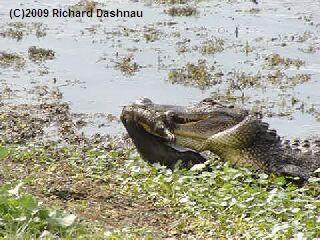 ------
------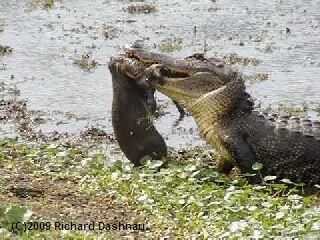 --------
--------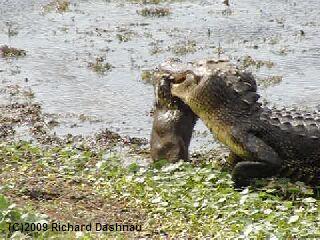 -
-
Gator
has repositioned the
prey.
The gator lifts its body and
head.
Gator cocks its snout right. Lifts foreleg.
Tremendous
jaw muscles clamp
shut.
This clears the carcass from the
ground.
Lifted foreleg will allow body to fall foreward.
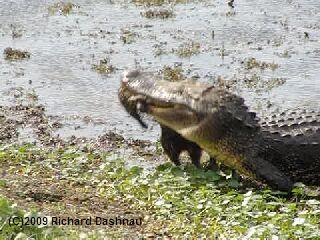 ------
------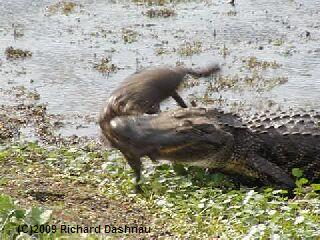 -===
-===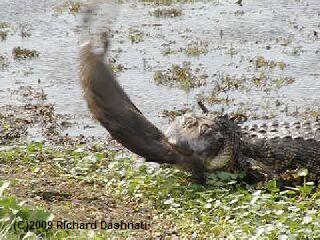 -
-
Gator
lets body fall
forward.
Gator body stops, but snout
continues.
Snout continues past body axis.
Snout
starts to swing with
fall.
Snout crosses body axis, carcass moving fast.
Centrifugal
force is increasing weight
Carcass
starts
acceleration.
at back end of carcass!
---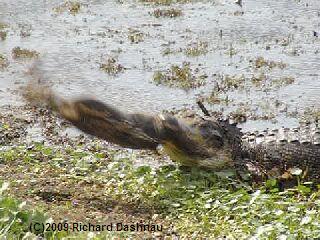 -
-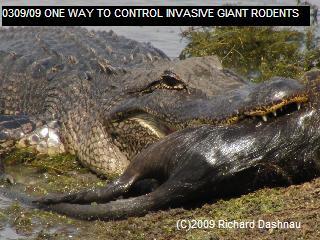
--Shoulders
of
gator move back relative to radius of carcass swing. Alligator's
snout
swivels back towards body axis and head moves straight
back, pulling section of body in jaws against increased weight of
rear
of carcass with hard jerk (the "whip"). Carcass extends
straight
as huge force is
brought to bear against swivel point just outside jaws.
Sooner or
later, this will cause the carcass to rip, or break, or part (and
it
does,
in the video clip).
I
am fascinated by the amount of mechanical interaction that is
brought
to
bear on something as apparently simple as just swallowing
something.
Also
in the clip is reference to a function
for that large pouch that can be
seen under the lower jaw on some alligators, especially as they
high
walk.
With the head held erect off the ground, this pouch is quite
visible.
This
is called
a "gular pouch" and helps guide prey down to the throat.
And, this page shows alligators at the park, on land, near various landmarks at the park.
Go back to my main alligator page, Alligators
Go
back to my home page, Welcome
to rickubis.com
Go
to the main
alligator page